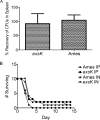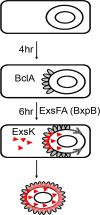Roles of the Bacillus anthracis spore protein ExsK in exosporium maturation and germination
- PMID: 19837802
- PMCID: PMC2786611
- DOI: 10.1128/JB.01110-09
Roles of the Bacillus anthracis spore protein ExsK in exosporium maturation and germination
Abstract
The Bacillus anthracis spore is the causative agent of the disease anthrax. The outermost structure of the B. anthracis spore, the exosporium, is a shell composed of approximately 20 proteins. The function of the exosporium remains poorly understood and is an area of active investigation. In this study, we analyzed the previously identified but uncharacterized exosporium protein ExsK. We found that, in contrast to other exosporium proteins, ExsK is present in at least two distinct locations, i.e., the spore surface as well as a more interior location underneath the exosporium. In spores that lack the exosporium basal layer protein ExsFA/BxpB, ExsK fails to encircle the spore and instead is present at only one spore pole, indicating that ExsK assembly to the spore is partially dependent on ExsFA/BxpB. In spores lacking the exosporium surface protein BclA, ExsK fails to mature into high-molecular-mass species observed in wild-type spores. These data suggest that the assembly and maturation of ExsK within the exosporium are dependent on ExsFA/BxpB and BclA. We also found that ExsK is not required for virulence in murine and guinea pig models but that it does inhibit germination. Based on these data, we propose a revised model of exosporium maturation and assembly and suggest a novel role for the exosporium in germination.
Figures








Similar articles
-
Localization and assembly of proteins comprising the outer structures of the Bacillus anthracis spore.Microbiology (Reading). 2009 Apr;155(Pt 4):1133-1145. doi: 10.1099/mic.0.023333-0. Microbiology (Reading). 2009. PMID: 19332815 Free PMC article.
-
Roles and Organization of BxpB (ExsFA) and ExsFB in the Exosporium Outer Basal Layer of Bacillus anthracis.J Bacteriol. 2022 Dec 20;204(12):e0029022. doi: 10.1128/jb.00290-22. Epub 2022 Nov 17. J Bacteriol. 2022. PMID: 36394311 Free PMC article.
-
An unusual mechanism of isopeptide bond formation attaches the collagenlike glycoprotein BclA to the exosporium of Bacillus anthracis.mBio. 2011 May 31;2(3):e00084-11. doi: 10.1128/mBio.00084-11. Print 2011. mBio. 2011. Retraction in: mBio. 2013 Nov 12;4(6):e00923-13. doi: 10.1128/mBio.00923-13. PMID: 21628501 Free PMC article. Retracted.
-
The Bacillus anthracis Exosporium: What's the Big "Hairy" Deal?Microbiol Spectr. 2015 Oct;3(5). doi: 10.1128/microbiolspec.TBS-0021-2015. Microbiol Spectr. 2015. PMID: 26542035 Review.
-
The Exosporium Layer of Bacterial Spores: a Connection to the Environment and the Infected Host.Microbiol Mol Biol Rev. 2015 Dec;79(4):437-57. doi: 10.1128/MMBR.00050-15. Microbiol Mol Biol Rev. 2015. PMID: 26512126 Free PMC article. Review.
Cited by
-
Coordinated Assembly of the Bacillus anthracis Coat and Exosporium during Bacterial Spore Outer Layer Formation.mBio. 2018 Nov 6;9(6):e01166-18. doi: 10.1128/mBio.01166-18. mBio. 2018. PMID: 30401771 Free PMC article.
-
Learning from Nature: Bacterial Spores as a Target for Current Technologies in Medicine (Review).Sovrem Tekhnologii Med. 2021;12(3):105-122. doi: 10.17691/stm2020.12.3.13. Epub 2020 Jun 28. Sovrem Tekhnologii Med. 2021. PMID: 34795986 Free PMC article. Review.
-
A genetic approach for the identification of exosporium assembly determinants of Bacillus anthracis.J Microbiol Methods. 2013 Apr;93(1):58-67. doi: 10.1016/j.mimet.2013.01.019. Epub 2013 Feb 11. J Microbiol Methods. 2013. PMID: 23411372 Free PMC article.
-
Characterization of Bacillus anthracis Spore Proteins Using a Nanoscaffold Vaccine Platform.Front Immunol. 2020 Jun 23;11:1264. doi: 10.3389/fimmu.2020.01264. eCollection 2020. Front Immunol. 2020. PMID: 32714323 Free PMC article.
-
Localization and assembly of the novel exosporium protein BetA of Bacillus anthracis.J Bacteriol. 2011 Oct;193(19):5098-104. doi: 10.1128/JB.05658-11. Epub 2011 Aug 5. J Bacteriol. 2011. PMID: 21821770 Free PMC article.
References
-
- Baillie, L., S. Hibbs, P. Tsai, G. L. Cao, and G. M. Rosen. 2005. Role of superoxide in the germination of Bacillus anthracis endospores. FEMS Microbiol. Lett. 245:33-38. - PubMed
-
- Ball, D. A., R. Taylor, S. J. Todd, C. Redmond, E. Couture-Tosi, P. Sylvestre, A. Moir, and P. A. Bullough. 2008. Structure of the exosporium and sublayers of spores of the Bacillus cereus family revealed by electron crystallography. Mol. Microbiol. 68:947-958. - PubMed
-
- Barlass, P. J., C. W. Houston, M. O. Clements, and A. Moir. 2002. Germination of Bacillus cereus spores in response to L-alanine and to inosine: the roles of gerL and gerQ operons. Microbiology 148:2089-2095. - PubMed
Publication types
MeSH terms
Substances
Grants and funding
LinkOut - more resources
Full Text Sources

